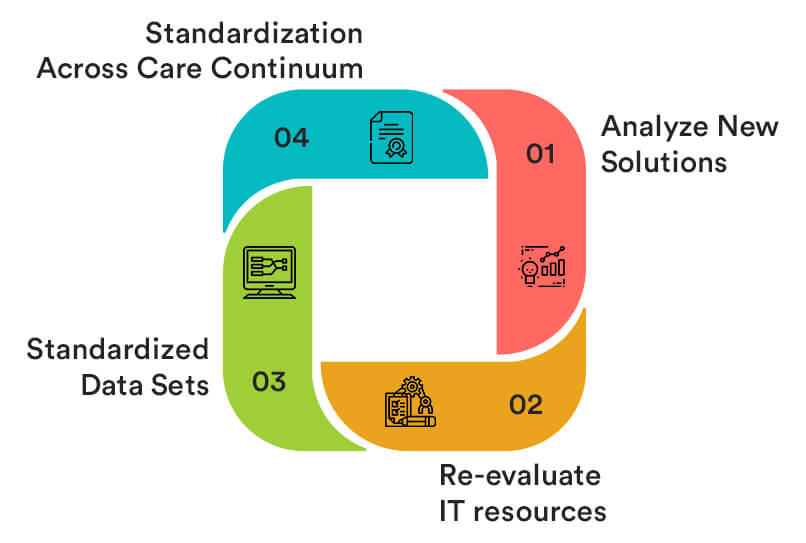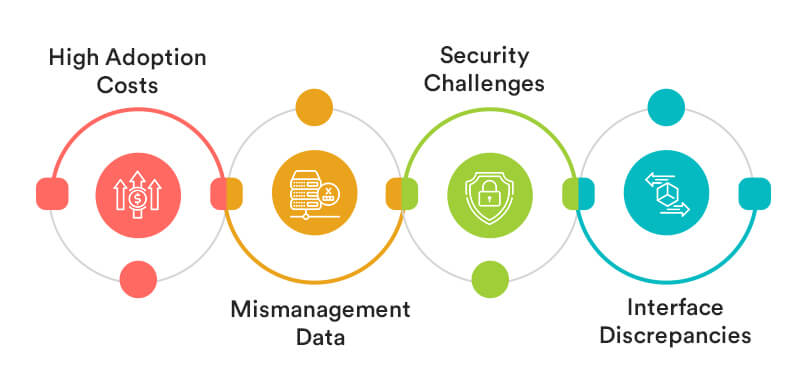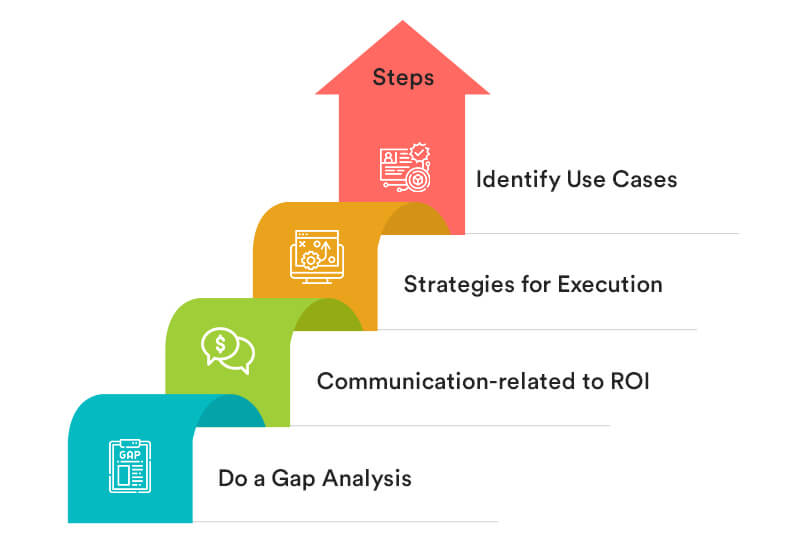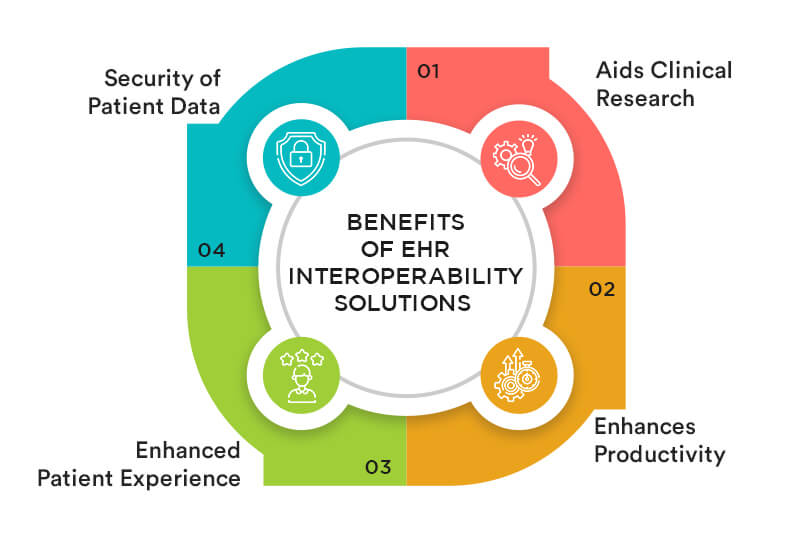Introduction:
EHR interoperability is the ability of EHR systems to exchange data with each other in electronic format. In other words, EHR interoperability in healthcare allows multiple providers to exchange patient data securely without hassle.
Today, Integrated healthcare solutions transform the complete system, boost complex tasks, enhance productivity, and improve the patient experience. A wide range of new technological solutions like advanced telehealth solutions, healthcare interoperability, remote patient monitoring systems, and more in the last few years. Besides, healthcare data management, sharing, and analytics are also critically important for quality care. Electronic Health Records and Electronic Medical Records are two systems that are currently the must-have solutions in healthcare. With providers adopting EHR and EMR, sharing data across different care settings posed severe threats to the information. Also, sharing across other interfaces was a challenge too. Healthcare software product development providers shared healthcare interoperability solutions to securely access and share health data across different platforms.
Industry CIOs and leaders, concerned about the sensitivity of health data and security issues, cited to comply with EHR interoperability solutions to optimize healthcare outcomes. EHR interoperability solutions are also the most discussed software today among providers. So, here’s everything you need to know about EHR interoperability solutions.
The Complete Guide to EHR Interoperability Solutions

Tips for Successful Implementation of EHR Interoperability Solutions
With the shift from traditional care roles to value-based care, providers have become more focused on patient experience. EHR interoperability technological solutions aim to boost care coordination and patient engagement systems within the organization. So, if you’re planning to boost your care delivery and patient satisfaction, here are a few tips for the successful implementation of EHR interoperability solutions.
1. Analyze New Solutions
Since EHR interoperability has been in the industry for quite some time now, but updated solutions are helpful for today’s problems. Providers must think ahead of EHR and its contribution in the future. So, EHR interoperability must include new solutions like test results, appointment scheduling, financial information, clinical documents, and more. Indeed, this will boost your patient experience.
2. Re-evaluate IT resources
Even though physicians actively use EHR systems, they opt for core EHR for insights and interoperability. This highlights the need for re-testing IT resources. Providers must timely re-evaluate their IT resources to cater to their needs and boost healthcare interoperability. Moreover, providers must ensure interoperability solutions in healthcare on four levels- semantic, foundational, structural, and organizational.
3. Standardized Data Sets
In EHR, no two data documentation practices are the same. Providers and custom healthcare software solutions vendors need to use a standardized data set for electronic data interchange. And when integrating EHR, maintaining a standardized data set ensures seamless interoperability. Moreover, the current standard followed is HL7.
4. Standardization Across Care Continuum
A recent report from Gartner highlighted that by 2023, nearly 35% of health organizations would opt for workflows out of the EHR system to provide better outcomes. So, providers must focus on the standardization of patient health data instead of EHR functionalities to promote healthcare interoperability.
Barriers in EHR Interoperability Solutions

Achieving EHR interoperability solutions facilitate better patient outcomes. However, multiple EHR interoperability challenges impact its successful implementation.
1. High Adoption Costs
Implementing the high cost of integration impacts EHR interoperability solutions. Providers’ financial constraint is the biggest barrier alongside their other organizational challenges. Besides, there are some affordable EHR interoperability integrated models available. But it’s best to opt for customized electronic health records interoperability, as it will cater to your requirements more efficiently.
2. Mismanagement Data
Health data management is an arduous task. Providers opt for automated healthcare solutions or medical informatics to manage their data in health care management. However, data errors such as inaccurate details affect the implementation of EHR interoperability solutions. So, providers need to ensure the proper data management practices to ensure efficient integration of EHR healthcare interoperability.
3. Security Challenges
One of the major challenges in healthcare is privacy and security issues. Health data is prone to security risks, and providers need to ensure HIPAA compliant solutions to mitigate this challenge. EHR systems and healthcare interoperability are all about data. So, providers must check with its HIPAA compliance to securely share data across the care settings.
4. Interface Discrepancies
Another barrier in implementing EHR interoperability is interface discrepancies. When data moves from one system/platform to another, the interoperable system must accurately route the information and transform it into a standard format. Provider’s EHR software must correctly exchange the data without losing during the translation process.
How to Implement EHR Interoperability Solutions

Understanding the barriers mentioned above in EHR interoperability solutions, you can adopt the right practices to implement EHR interoperability technology solutions successfully. Here are some of the essential steps to follow-
1. Identify Use Cases
For successful implementation of healthcare interoperability solutions, providers must correctly identify specific clinical cases, data types, and entities
2. Strategies for Execution
Providers need to involve in strategic planning for implementing the EHR/EMR interoperability. Planning will ensure informed decision-making, timeframe, and cost of the process. So, providers can achieve their interoperability goals without much fuss.
3. Communication-related to ROI
It’s essential to communicate important revenue expectations to all the stakeholders. This will boost interoperability systems and help the organization achieve its goals.
4. Do a Gap Analysis
Success of EHR implementation is a critical task. So, providers must conduct a gap analysis to understand the potential limitations and devise effective solutions.
Benefits of EHR Interoperability Solutions

There is no debate about the varied benefits of EHR Interoperability solutions. Of all the pros of EHR interoperability in healthcare, here are some major benefits.
1. AIDS Clinical Research
It’s a known fact that data is highly crucial to clinical research. With seamless EHR interoperability across the care continuum, clinical researchers easily access required data. Moreover, interoperable systems allow providers to share data with scientists to facilitate their research.
2. Enhances Productivity
EHR systems that are interoperable saves times and money alongside reducing the work pressure of the staff. Moreover, digitization data removes redundancy, errors and improves processing speed to ensure faster action by providers.
3. Enhanced Patient Experience
In addition to the quality of care and treatments themselves, there are other factors, big and small, that affect patients’ overall experience with an episode of care. Things like the time taken for insurance verification, retrieving medical data from another provider, billing, and claims management go a long way in determining how patients feel about receiving care. EHR interoperability solutions expedite all of these processes and improve their accuracy. As a result, providers and patients benefit from the boost in speed and productivity.
For patients, this means reduced waiting times for consultations or important procedures, not to mention fast and hassle-free billing processes.
Providers can focus on patient care completely with increased productivity. Easy access to data helps clinicians make decisions to improve patients’ diagnoses and outcomes. And this eventually improves the patient experience and practice management solutions too.
4. Security of Patient Data
One of the major benefits of EHR interoperable solutions is the security of patient health data. Since health data have higher chances of getting hacked or attacked, health leaders and providers ensure regulatory compliant EHR systems. Moreover, EHR interoperability also secures the patient data by constant tracking and assessing it. Besides, the care providers have complete control and rights to see how the PHI is used.
5. Inter-Organization Communication
This is one of the biggest advantages of implementing EHR interoperability solutions. They enable different healthcare organizations to exchange medical data seamlessly. This greatly boosts productivity for all stakeholders involved since gaps in patient data often hamper clinical and administrative activities.
For example, a hospital or a clinic with electronic health records software and healthcare interoperability can send and receive data to a pharmacy or a lab testing center. These organizations can exchange important patient data, such as test results, prescriptions, clarification requests, and billing information.
6. Potential For Automation
EHR interoperability solutions pave the way for easy information interchange among medical software solutions. This means that an EHR containing patient data can be interlinked with other solutions to leverage cutting-edge technologies in automation. Software automation programs can be used with EHR to retrieve clinical and operational data from other processes. This data can then be processed through automation to highlight useful insights that would help providers and administrators better serve all the stakeholders.
7. Scalability
As a clinic or hospital grows in size and expands its services, scaling up the capacity of an existing hospital system becomes necessary to accommodate the increase in size. Healthcare interoperability solutions enable newer medical applications to seamlessly merge alongside existing systems. This enables existing hospital systems or clinical software to be scaled up in functionality without needing costly re-vamps or replacements.
EHR interoperability solutions facilitate the exchange of data among software systems. This provides a vital means of including additional software solutions and helps healthcare organizations adopt newer technologies. While adopting new technologies often comes at a great cost, healthcare interoperability software eliminates the need for costly purchases and expands existing systems to take in new applications.
8. Reduced Operational Costs
This is a major advantage of using EHR interoperability solutions to integrate different healthcare software. It enables the entire clinical and administrative staff to access important data rapidly and securely. In doing so, the EHR or EMR integrated solutions eliminate the need for handling physical documentation, which saves all the overhead related to the storage and management of information. Hospitals are bound to deal with increasing paperwork and documentation associated with patient care and everyday operations as they get bigger and bigger.
So, EHR interoperability solutions that integrate all the digital assets of a hospital or clinic save a significant amount of overhead in the long run. Additionally, this also saves large quantities of paper, lowering the hospital’s carbon footprint immensely. Lowering operational overhead and significantly reducing paper usage is a double victory facilitated by the interoperability of electronic health record software with healthcare systems.
EHR Interoperability and Remote Patient Monitoring
Remote patient monitoring (RPM) involves monitoring patient health outside conventional clinical settings. In simple words, dedicated RPM technologies collect patients’ health vitals like heart rate, blood pressure, blood glucose levels, body temperature, oxygen saturation, and others. The devices that monitor these parameters transmit them in real time from a patient to a doctor at a remote location. In this way, RPM allows doctors to monitor patients without the patients being at a clinic.
EHR interoperability technology solutions enable clinics and healthcare centers to incorporate these RPM devices into their medical workflows. That would enable doctors to have real-time data on patient vitals for assessment. As mentioned above, electronic health record interoperability enables the inclusion of newer technologies, and so, RPM coupled with advanced patient data analytics helps providers serve patients better.
Continuous real-time medical data on patients and its subsequent analysis against specific parameters helps doctors identify if a patient is at higher risk of disease. For example, a person’s heart rate and electrocardiogram obtained through RPM devices can help a physician know if he or she is at risk of health disease. This will enable the physician to recognize early symptoms and take necessary action before the disease manifests. Such a predictive approach to care can revolutionize the treatment of chronic diseases and enable doctors and patients to manage medical conditions better.
The assimilation of RPM solutions into mainstream health systems has the added advantage of extending access to care further. People living in distant, rural communities who lack access to specialist care can leverage the power of remote patient monitoring solutions and stay in touch with physicians at metropolitan hospitals. Additionally, integrating RPM into health systems greatly benefits elders at retirement homes and assisted living facilities. They are likely to face difficulty traveling to see physicians, so the ability to monitor their health vitals remotely is a suitable solution to make up for the absence of caregivers and keep the costs low.
One of the most impactful applications of the integration of RPM through healthcare interoperability is during pandemics. The recent Covid-19 pandemic restricted travel and made it risky to go to clinics. During such disease outbreaks, using EHR interoperability solutions to leverage remote patient monitoring technologies will provide access to care for people who need it. This is especially true of people suffering from chronic conditions but face travel restrictions.
Remote patient monitoring technologies can change the way we approach non-critical care. But its widespread adoption and implementation through healthcare interoperability software solutions is an ongoing process. The use of wearable IoT devices like smartwatches has increased the adoption rate of such solutions. It won’t be surprising to see interoperability solutions maximize the use of RPM within health information systems.
The Role of EHR Interoperability Solutions in Telehealth
Telehealth is the use of digital and telecommunication technologies for the dissemination of medical services. Telehealth software allows patients to access medical services without having in-person visits with their doctor. It can be said to fall under the broader umbrella term of remote patient monitoring. However, unlike RPM, telehealth enables people to have remote consultations with their doctors.
EHR/EMR interoperability solutions can integrate telehealth platforms into practice management or hospital information systems. This will enable patients to communicate with their providers remotely from the privacy of their own homes over the internet. This lowers the cost of care and helps people with disability and transportation troubles receive the care they need.
Telehealth software allows patients to log in securely and have a private virtual consultation session with their doctor. Moreover, some telehealth platforms also feature chatbots to help people reach out to their doctors to clarify doubts without booking consultations. Integrating EHR solutions with telehealth platforms will enable physicians to view patient histories during a virtual consultation and provide better care. That is why telehealth software became highly sought-after during the Covid-19 pandemic when it was risky to travel.
One of the most significant applications of interoperability solutions in healthcare is their use for integrating telehealth solutions with mental health management platforms. This will enable people to access mental health care from the comfort and privacy of their own houses using nothing more than a smartphone and an internet connection. The United States is facing a shortage of mental care professionals. A significant portion of the population lives in locations without a single therapist. Integrating telehealth platforms with mental EMR systems can alleviate this problem and enable thousands of people to access mental care.
EMR interoperability solutions can play a major role in extending access to mental healthcare across the country. Seamless integration of EMR/EHR with telehealth applications can help millions of Americans cope better.
Conclusion
EHR interoperability today plays a great role in aiding providers with increased productivity and seamless data exchange for better patient outcomes. After all, patient data in EHR and EMR systems are the real wealth in improving care delivery and treatments. Even it helps in predictive analysis. Moreover, providers must also oversee the software and handling aspects for maximum benefit. Providers using healthcare cloud computing solutions can easily integrate EHR interoperability solutions into their existing systems, eliminating the hassle of choosing the right vendor and additional costs. Above all, EHR interoperability will reach its peak and witness more advancement in the future.
The healthcare industry continues to experience innovations every few years and faces challenges in adopting them. The increasing penetration of technology into all aspects of the industry has prompted many investors to pour increasing amounts of money into developing novel medical technologies. The implementation and usage of these technologies through integration would require the development of newer EHR interoperability standards. These standards, coupled with the interoperability software solutions themselves, will play a major role in charting the roadmap of healthcare technology in this decade.
OSP is a trusted software development company that delivers bespoke solutions as per your business needs. Connect with us to hire the best talents in the industry to build enterprise-grade software.

How can we help?
Fill out the short form below or call us at (888) 846-5382
Looking for software solutions to build your product?
Let's discuss your software solutions for your product in our free development acceleration call!
Get In Touch arrow_forwardDiscuss Your Project Handover with a team of expert Book a free consultation arrow_forward
About Author

Written by Riken Shah linkedin
Riken's work motto is to help healthcare providers use technological advancements to make healthcare easily accessible to all stakeholders, from providers to patients. Under his leadership and guidance, OSP Labs has successfully developed over 600 customized software solutions for 200+ healthcare clients across continents.

















